
Who doesn’t love a good cursed book? In a post on Mental Floss, April Snellings describes eight that you can steal use in your writing.
- The Codex Gigas. At three feet in height and 165 pounds, the Devi’s Bible is believed to be the world’s largest surviving medieval book. Possibly written in early 13th century Bohemia by a single scribe, the book contains both the Old and New Testaments, along with Czech and Jewish history texts; an encyclopedia with information on geometry, legal matters, and entertainment, among other topics; medical treatises; hundreds of obituaries; several magic spells; and a calendar. Also, a full color portrait of the Devil, who purportedly helped the monk create the tome in a single night.
- The Book of Soyga. An occult text from the 1500s (or possibly before), this book was once owned by polymath and occultist John Dee. The Book of Soyga includes magical spells and writings about demonology and astrology, as well as the names and genealogies of angels, and a divine message written in the language God spoke to Adam. Dee and his friend Edward Kelley asked the angel Uriel for help translating it, but only the archangel Micheal could do so. Allegedly.
- The Book of the Sacred Magic of Abramelin the Mage. A Jewish magic text from the 14th or 15th century, the book was adopted by the more recent magicians of the Hermetic Order of the Golden Dawn, one of whom translated it into English. Supposedly one of Alistair Crowley’s inspirations, the book describes an elaborate, multi-month ritual allowing the sorcerer to commune with their “Holy Guardian Angel” for three days. After that, though, the sorcerer must defeat each demon of hell. Tall order.
- The Orphan’s Story. A novel written by a Spanish monk in the early 1600s, The Orphan’s Story was long believed lost. A copy turned up in 1965 but was not immediately published, as people associated with the project died mysterious deaths. It finally appeared in print in 2017.
- The Grand Grimoire. Described as one of the four specific handbooks of Black Magic, the book contains detailed instructions for summoning Satanic sidekick Lucifugé Rofocale. Widely distributed throughout France, the book was seen as a threat to the Church’s authority.
- The Great Omar. A translation of works by Omar Khayyám, an elaborate handmade edition made in 1911 has a tainted reputation. Renowned bookbinder Francis Sangorski borrowed a human skull for artistic reference and paid a zookeeper to feed a live rat to a snake so he could observe the reptile feeding. According to the BBC, he used 100 square feet of gold leaf, 5000 pieces of leather, and more than 1000 precious gemstones, including rubies, topazes, and emeralds to make the edition, and eventually had trouble finding someone to meet his £1000 asking price. Sangorski eventually found a U.S. buyer and sent the tome to America…via the Titanic. Ten weeks later, Sangorski himself drowned. His masterpiece was never recovered, but a duplicate was made…and destroyed during World War II. A third try is currently housed in the British Museum.
- Written in Blood. Written by Robert and Nancy Heinl, who spent years enmeshed in Haiti’s political turmoil, the book was allegedly cursed by voodoo due to its negative depiction of François “Papa Doc” Duvalier. The manuscript was initially lost, then stolen. When it was finally set for publishing, the folding machine malfunctioned and a report assigned to cover its released fell ill with appendicitis. The Heinls suffered a series of misfortunes over the years, and Robert died suddenly of a heart attack as the couple vacationed in the French West Indies.
- “Tomino’s Hell.” A poem written by Japanese poet and songwriter Saijō Yaso, the verse recounts a young boy’s journey through Hell, possibly as an allegory for deployment to war. Its legend took form after a filmmaker used the poem as inspiration for a movie. He died nine years later. An internet urban legend says that a college student died after reading the poem.











